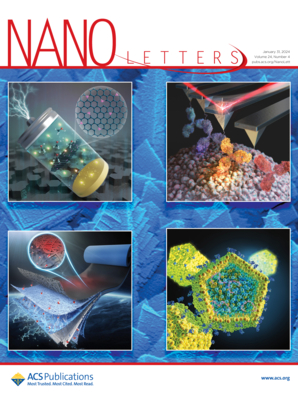量子点级联衰减中光子不可分辨性的电场控制
IF 9.1
1区 材料科学
Q1 CHEMISTRY, MULTIDISCIPLINARY
引用次数: 0
摘要
光子不可分辨、纠缠和反聚束是量子光学和光子学的关键组成部分。量子发射体中的衰减级联提供了一种简单的方法来产生多对产生概率可忽略不计的纠缠光子对。然而,在级联中发射的光子的不可分辨程度本质上受到相关跃迁的寿命比的限制。在这里,我们表明,对于量子点中的双激子-激子级联,该比例可以通过外加电场广泛调节。对两个随后发射的双激子光子的Hong-Ou-Mandel干涉测量表明,它们的不可分辨性随着场的增加而增加,符合理论预测的行为。同时,发射线宽度保持在变换极限附近,有利于依赖于不同光源发射的光子之间干涉的应用。本文章由计算机程序翻译,如有差异,请以英文原文为准。

Electric-Field Control of Photon Indistinguishability in Cascaded Decays in Quantum Dots
Photon indistinguishability, entanglement, and antibunching are key ingredients in quantum optics and photonics. Decay cascades in quantum emitters offer a simple method to create entangled-photon-pairs with negligible multipair generation probability. However, the degree of indistinguishability of the photons emitted in a cascade is intrinsically limited by the lifetime ratio of the involved transitions. Here we show that, for the biexciton–exciton cascade in a quantum dot, this ratio can be widely tuned by an applied electric field. Hong-Ou-Mandel interference measurements of two subsequently emitted biexciton photons show that their indistinguishability increases with increasing field, following the theoretically predicted behavior. At the same time, the emission line width stays close to the transform-limit, favoring applications relying on the interference among photons emitted by different sources.
求助全文
通过发布文献求助,成功后即可免费获取论文全文。
去求助
来源期刊

Nano Letters
工程技术-材料科学:综合
CiteScore
16.80
自引率
2.80%
发文量
1182
审稿时长
1.4 months
期刊介绍:
Nano Letters serves as a dynamic platform for promptly disseminating original results in fundamental, applied, and emerging research across all facets of nanoscience and nanotechnology. A pivotal criterion for inclusion within Nano Letters is the convergence of at least two different areas or disciplines, ensuring a rich interdisciplinary scope. The journal is dedicated to fostering exploration in diverse areas, including:
- Experimental and theoretical findings on physical, chemical, and biological phenomena at the nanoscale
- Synthesis, characterization, and processing of organic, inorganic, polymer, and hybrid nanomaterials through physical, chemical, and biological methodologies
- Modeling and simulation of synthetic, assembly, and interaction processes
- Realization of integrated nanostructures and nano-engineered devices exhibiting advanced performance
- Applications of nanoscale materials in living and environmental systems
Nano Letters is committed to advancing and showcasing groundbreaking research that intersects various domains, fostering innovation and collaboration in the ever-evolving field of nanoscience and nanotechnology.
 求助内容:
求助内容: 应助结果提醒方式:
应助结果提醒方式:


